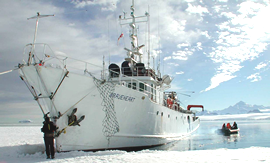One of the objectives for our visit to the Kermadec Islands was to collect blood and feather samples from Kermadec Petrels and investigate whether there are two separate populations of these petrels. After an initial burst of finding eight chicks in one day on Raoul (see earlier blog) and several days of fruitless searching at a number of headlands around the island we turned our attention to the Meyer Islands. These small rugged islands lie a few kilometres to the northeast of Raoul.
A break in the whale team’s schedule offered a window of opportunity (bless you, Rochelle) and using one of the Braveheart’s zodiacs, skipper Matt Jolly took Mark, Di Makotter (the DOC team leader), Emma McCool (another of the DOC rangers) and myself across early to North Meyer Island. Rochelle and her team were going ashore onto Raoul for the afternoon, a very welcome change from the rocking and rolling while at anchor and racing about in the zodiacs in all conditions.

Mark and Emma McCool measuring a chick at the summit of North Meyer Island.
Our permit allows us to collect up to 30 samples from Kermadec Petrels and, as this was most likely going to be our only chance of getting across to the Meyers, we had our work cut out to collect the additional 22 samples. We’re very much at the end of the ‘winter breeding’ season for these birds – most chicks having departed – and this was especially noticeable on the Meyers where thousands of birds had been reported by DOC staff back in April and May.
We soon found we would have to climb the island to the top to find enough birds. Through the morning we were finding almost-fledged chicks as we carefully picked our way up the incredibly fragile burrow-ridden soil slopes; worming through trunks and branches of gnarled ngaio, pohutukawa and parapara and stepping on rocks to avoid crushing burrows. However, later in the day we saw more and more flying activity of adult birds over the island, and later still, birds landing, though not to feed chicks. At the summit we found some birds’ nest building or sitting on nests – marking what appears to be a clear disjuncture between the departing chicks and these adult birds right at the start of breeding with none in between. Whether this translates through to a genetic distinction between winter and summer breeders remains to be seen.
Bang on 5pm and time to start making our way down to the landing site we completed our 30th sample. We’ve sampled mostly chicks but have also included 8 of these adults to go with samples collected in 2008.
At this time of the year the Meyer Islands appear relatively quiet, however appearances deceive. While the many Black-winged Petrels, Wedge-tailed Shearwaters, most of the summer-breeding Kermadec Petrels, the spectacular Red-tailed Tropicbirds Sooty Terns and most of the Masked Boobies have yet to return, only the Black and Grey Noddies, and some Masked Boobies were visible; they all were in the early stages of nesting. But hidden from sight in burrows in the soft soil were hundreds of Kermadec Little Shearwater chicks, possibly thousands given the numbers we saw or were aware of as we climbed to the summit.
We were back down at the rocky shore before our scheduled pick-up time and enjoyed some fish-gazing, the highlight a very large groper at the surface and sliding along the base of the rock ledge we were standing on. There were also two big schools of fish feeding on what looked like tiny crustaceans, a decent plankton soup, and a decent sized Galapagos Shark. Then it was back into the zodiac and a quick dash back to Fishing Rock Landing, then the DOC base in time for dinner!












